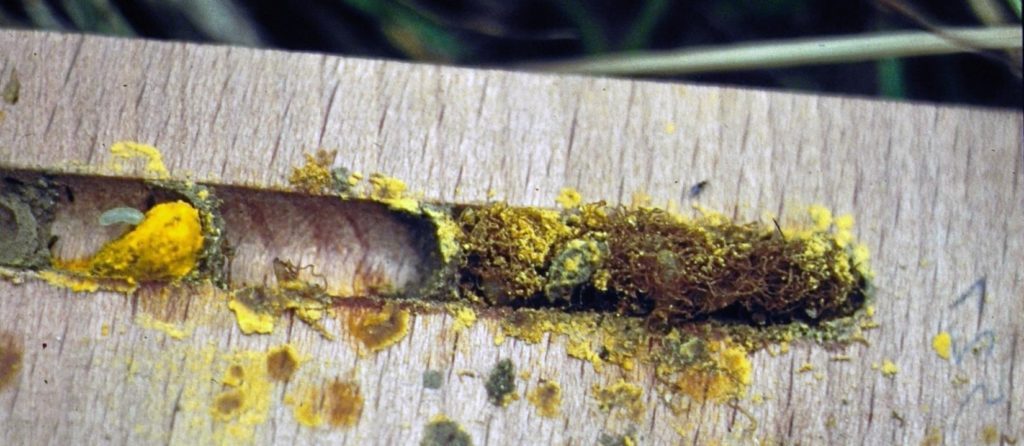Though my “bee-career” began with floral ecology, cleptoparasites very soon got my attention. For my master thesis I examined the associated species found in nests of the Red Mason Bee, Osmia bicornis (in that times still O. rufa). I had tried another subject before (still with bees) but did not succeed much in it. In this time, I observed very often the four “nesting walls” in the bee garden of the university. The garden was full of flowers, there were also structures for bees and other aculeates not nesting in trap nests.

Early summer 1997 in the Bee Garden of the University of Bielefeld
This bee garden was my playground for two summers. In the first; all these different species of bees and solitary wasps buzzing around the nest sites and the flowers fascinated me. Trapsnests seemed to be a whole little world, a microcosm for itself. As I said, I did not succeed with my first topic; but discovered the subject that lead me to the degree: cleptoparasites.
Cleptoparasites associated with Osmia bicornis
The most common species in the bee garden was the Red Mason Bee. They occupied big parts of wooden trap nests and plexiglas pipes we offered for nesting. The choice of the species to observe for a thesis in a limited time frame was therefore obvious (though I had much more liberties than students nowadays). The first step was to determine the species living in the nests of O. bicornis. I found five of them:
- Cacoxenus indagator: this fly is a relative of fruit flies, those which you find in your fruit and organic waste in summer. They live in the nests of different Mason Bee species. They are not really parasites in the strict sense of the word: they feed on the provisions for the host larva. Thus, they “starve it out” . Infested cells are easy to recognize: they are full of filamentous faeces.

The fruit fly Cacoxenus indagator fills the brood cell with their faeces
- Melittobia acasta: This is a parasite, they feed on the young larva’s haemolymph. The female lays its eggs directly on the host and feeds on them, too.

Melittobia acasta and her larvae.
- Monodontomerus obscurus: this parasitoid infests different bee species, with a preference for megachilids. They pierce the cocoon to lay their eggs. The larvae then feed the host pupae. I found these only because I wanted to determine the sex of the bees in the cocoons and then sometimes found this:

Surprise while sexing O. bicornis: Monodontomerus obscurus larvae. They are up to 22 parasite larvae in a cocoon.
- Ptinus sexpunctatus: this beetle was a rather rare event and I found it only in the wooden trapnests. Those I opened regularly to control the bee larvae… maybe, I was the “door-opener” for this species. Like C. indagator, they feed on the food provisions of the host larva.

Characteristic larva of Ptinus sexpunctatus in its “strawy” faeces.
- Finally, there was also a mite: Chaetodactylus osmiae. They live on different Osmia species and all life stages are associated to the host. Infested cells are filled with powdery pollen, left behind by the feeding mite. Before they get to the pollen though, they also suck the host’s egg. Not always, however, as this picture shows.

Chaetodactylus osmiae covering O. bicornis cocoons.
Later on, I analysed the mortality caused by the different cleptoparasites and its portion in general causes of death of the larva. I also compared different locations, to see if there were differences in their parasite species composition. But I will tell you about this in another post.



